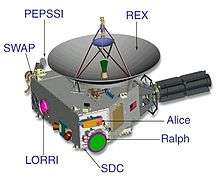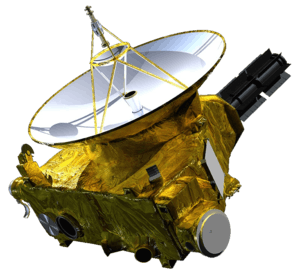Venetia Burney Student Dust Counter


New Horizons · (486958) 2014 MU69 · Earth · 132524 APL · Jupiter · Pluto VBSDC can record micron size dust impacts on NH's route away from the Sun and past Pluto
The Venetia Burney Student Dust Counter (VBSDC) is a scientific instrument aboard the unmanned New Horizons space probe that is designed to detect dust impacts in outer space.[1] VBSDC is the first planetary science instrument to built by students.[2] The dust counter was launched in 2006, and named later that year after Venetia Burney.[3] The detector works when dust strikes films of polarized polyvinylidene fluoride (PVDF), which generates an electrical charge.[4] The dust is then detected over the course of the New Horizon's spacecraft flight out of the solar system and passed Pluto.[5]
In 2010, VBSDC collected data on dust past 18 AU 1.67 billion miles, which is the distance the Pioneer 10 & 11 dust counters stopped working.[6] Five other spacecraft have carried dust detectors beyond the asteroid belt including Pione ers 10 and 11, Ulysses (heliocentric orbit out to the distance of Jupiter), Galileo (Jupiter Orbiter), and Cassini (Saturn orbiter).[7] The Voyager 1&2 spacecraft did detect dust by using data from the Plasma Wave instrument, but did not have dedicated dust detection instruments.[8] The Pioneer dust detectors stopped working at 18 AU.[9]
The impacts of the dust is calculated to provide the mass and the velocity of the dust.[10] One of the natural structures of the solar system the VBSDC is design to detect, is the Zodiacal cloud.[11]
The detector is designed to detect dust between 10−9 and 10−12 in mass and between 0.5 and 10 micro(μ) meters in size.[12] By early 2012, the dust counter and produced data along a 23 AU path out the solar system.[13] By 2008 it had taken dust measurements between 1.2 and 11 AU.[14]
The direction of the dust impact is calculated by noting what direction the instrument is facing due to the orientation of the spacecraft.[15] The instrument has very low power consumption.[16]
Examples of periods of Measurements:[17]
- 6.76-7.10 A.U.
- 9.02-9.91 A.U.
- 10.01-10.80 A.U.
- 11.91-13.84 A.U.
- 14.29-15.51 A.U
VBSDC recorded the first measurements of sub-micron space dust in the outer solar system.[18] In the outer solar system VBSDC recorded an average flux of dust of grain size larger than 2 × 10−12 grams of 2.5 × 10−4 m−2 s−1.[19]
Naming
In June 2006 the student dust counter was named in honor of Venetia Phair (née Burney) who came up with name Pluto in the 1930s as girl, and she was given a plaque related to this naming December 2006.[20] Venetia suggested the name Pluto after the discovery of the new planet by Clyde Tombaugh in 1930 at Lowell Observatory.[21] The name Pluto was selected in a vote by the observatory's astronomers.[22]
Previously the instrument was called the Student Dust Counter.[23]
References
- ↑ Poppe, Andrew; James, David; Jacobsmeyer, Brian; Horányi, Mihály (2010-06). "First results from the Venetia Burney Student Dust Counter on the New Horizons mission". Geophysical Research Letters. 37 (11): n/a–n/a. doi:10.1029/2010gl043300. ISSN 0094-8276. Check date values in:
|date=(help) - ↑ JHUAPL. "Student Dust Counter instrument breaks distance record". New Horizons. Retrieved 2018-10-13.
- ↑ JHUAPL. "Student Dust Counter instrument breaks distance record". New Horizons. Retrieved 2018-10-13.
- ↑
- ↑
- ↑ JHUAPL. "Student Dust Counter instrument breaks distance record". New Horizons. Retrieved 2018-10-13.
- ↑
- ↑
- ↑
- ↑ Poppe, Andrew; James, David; Jacobsmeyer, Brian; Horányi, Mihály (2010-06). "First results from the Venetia Burney Student Dust Counter on the New Horizons mission". Geophysical Research Letters. 37 (11): n/a–n/a. doi:10.1029/2010gl043300. ISSN 0094-8276. Check date values in:
|date=(help) - ↑
- ↑
- ↑
- ↑ James, D; Poppe, Andrew; Horanyi, Mihaly (2008-12-01). "Dust Measurements Between Earth and Saturn by the Venetia Burney Student Dust Counter of the New Horizons Mission". AGU Fall Meeting Abstracts.
- ↑ Poppe, Andrew; James, David; Jacobsmeyer, Brian; Horányi, Mihály (2010-06). "First results from the Venetia Burney Student Dust Counter on the New Horizons mission". Geophysical Research Letters. 37 (11): n/a–n/a. doi:10.1029/2010gl043300. ISSN 0094-8276. Check date values in:
|date=(help) - ↑
- ↑
- ↑ Poppe, Andrew; James, David; Jacobsmeyer, Brian; Horányi, Mihály (2010-06). "First results from the Venetia Burney Student Dust Counter on the New Horizons mission". Geophysical Research Letters. 37 (11): n/a–n/a. doi:10.1029/2010gl043300. ISSN 0094-8276. Check date values in:
|date=(help) - ↑ Poppe, Andrew; James, David; Jacobsmeyer, Brian; Horányi, Mihály (2010-06). "First results from the Venetia Burney Student Dust Counter on the New Horizons mission". Geophysical Research Letters. 37 (11): n/a–n/a. doi:10.1029/2010gl043300. ISSN 0094-8276. Check date values in:
|date=(help) - ↑ JHUAPL. "New Horizons Team Remembers Venetia Phair, the 'Girl Who Named Pluto'". New Horizons. Retrieved 2018-10-13.
- ↑ Thompson, Helen. "How Pluto Got Its Name". Smithsonian. Retrieved 2018-10-13.
- ↑ Thompson, Helen. "How Pluto Got Its Name". Smithsonian. Retrieved 2018-10-13.
- ↑
